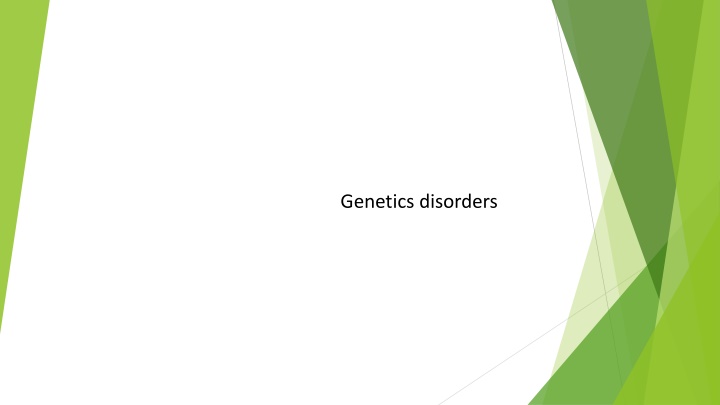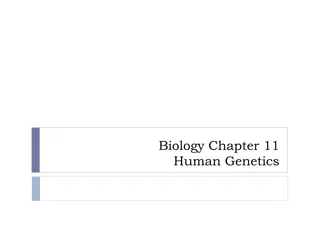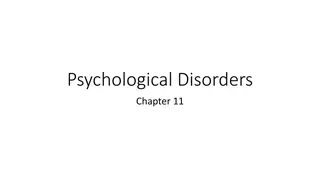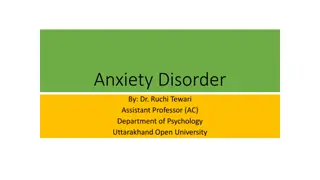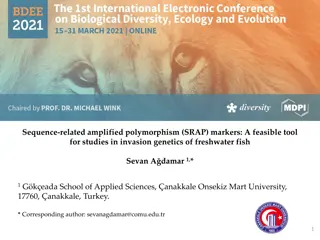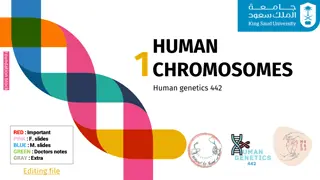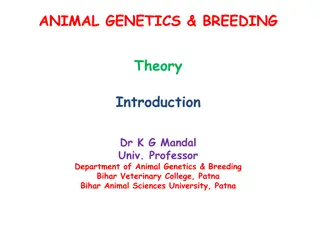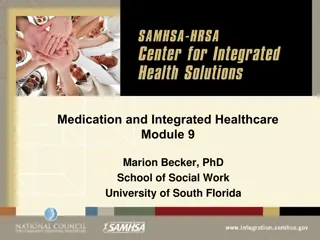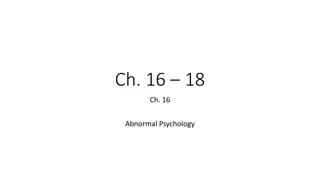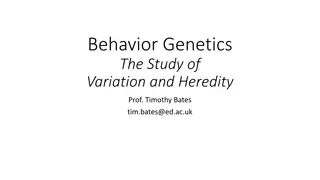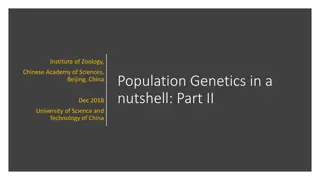Genetic Disorders
Genetic disorders result from alterations in DNA sequences, caused by mutations in genes, environmental factors, or chromosome damage. Learn about conditions like Fragile-X syndrome, Hemophilia A, Duchenne Muscular Dystrophy, Color Blindness, Alzheimer's Disease, and Chronic Myeloid Leukemia.
Download Presentation

Please find below an Image/Link to download the presentation.
The content on the website is provided AS IS for your information and personal use only. It may not be sold, licensed, or shared on other websites without obtaining consent from the author.If you encounter any issues during the download, it is possible that the publisher has removed the file from their server.
You are allowed to download the files provided on this website for personal or commercial use, subject to the condition that they are used lawfully. All files are the property of their respective owners.
The content on the website is provided AS IS for your information and personal use only. It may not be sold, licensed, or shared on other websites without obtaining consent from the author.
E N D
Presentation Transcript
A genetic disorder is a disease caused via an alternation in the DNA sequence. Genetic disorders can be caused by a mutation in one gene, or mutations in multiple genes or a combination of gene mutations and environmental factors, or by damage to chromosomes. Some genetics disorders are caused by mutations that are inherited from the parents, like sickle cell disease. Or acquired mutations in a gene or group of genes that occur during a person's life. Such mutations occur either randomly or due to some environmental exposure (such as cigarette smoke), include many cancers.
Disease linked to X-chromosome: Fragile-X syndrome (FXS): Dominant disease, happens due to mutation in FMR1 causing a repeat of CGG sequence up to 200 time. Frequency 1:4000 in male and 1:8000 in female. Symptoms: Learning disability, cognitive impairment.
Haemophilia A: Known as factor VIII (FVIII), Recessive disease, mutation is found in F8 gene (clotting protein). People who have a Haemophilia A tend to bleed longer than a normal people. Normal level = 50%-150% of FVIII in blood. According to the concentration of FVIII in blood Haemophilia A is divided into: Mild Haemophilia A is 6% -49% of FVIII in blood. Moderate Heamophila A is 1% -5% of FVIII in blood. Severe Heamophila A is less than 1%
Duchenne Muscular Dystrophy (DMD): Recessive disease, protein Dystrophin is missing in muscle cells which make them fragile and easily damaged. Muscles are degenerated and weak. Muscles weakness can be observed around age of 3, first affecting muscles that located in Hips, pelvic area, thigh and then shoulders. Followed by arms, legs and trunk.
Color blindness: (color vision deficiency). Recessive disease, mutation exists in OPN1LW, OPN1MW and OPN1SW. These gene produce proteins found in retina, which is light sensitive tissue , located in the back of eye. Retina contains rods and cones cells receptor. Cones are responsible for color vision. Affected are not able to distinguish between red, green, blue and yellow color. Disrupt color reception but not Eyes vision.
Disease linked to autosomal chromosomes: Alzheimer's Disease: Dominant disease, lead to degeneration of neuronal cells. Aberration of Genes that are placed in Chromsomes 1 (PSEN2),14 (PSEN1), 19 (APOE) and 21 (APP) may cause Alzaheimer. Chronic myeloid leukemia (CML): It happens when there is an injury to the DNA of a single bone marrow cell. Patients carries a shorter 22 chromosome compared to healthy people which called Philadelphia chromosome. Translocation between Chromosome 9 and 22. So, ABL gene on Ch9 fuses with BCR gene on Ch 22. Resulting in create a fusion protein ABL-BCR that causes abnormal regulation of cell growth and involve in CML development.
Pancreatic cancer: Some genes are involved in initiate pancreatic cancer for example: KRAS2, p16/CDKN2A, TP53, and SMAD4/DPC4. Atherosclerosis: Mutation on APOE gene which produces a protein called Apolipoprotein. This protein transfers the cholesterol from blood to liver cells and being recognized by the liver receptors before entering liver cells. Attention: disease normally happens due to genetics mutation as well as some environmental element such as food.
Diabetes (type I) This disorder is characterized by aberrant high blood sugar levels. In the pancreases, there are specialized cells named beta cell stop releasing insulin. Lack of insulin leads to the inability to use glucose for energy or to control the amount of sugar in the blood. Type 1 diabetes is generally considered to be an autoimmune disorder. Autoimmune disorders happen when the immune system attacks the body's own tissues and organs. A certain variant of genes belong HLA complex family include HLA-DQA1, HLA-DQB1, and HLA-DRB1, cause in inappropriate immune respond to beta cell.
Sickle cell anemia: It is an autosomal recessive disease. Mutation is found in HBB gene which affects hemoglobin, the molecule in red blood cells that delivers oxygen to cells throughout the body. Hemoglobin composed of 4 protein subunits (2 alpha-globin and 2 Beta- globin). Mutation in HBB gene produce hemoglobin S. People with this disorder have a typical hemoglobin molecules called hemoglobin S, which can distort red blood cells into a sickle, or crescent, shape.
Sickle cell anemia Red blood cells carry oxygen to the body and appear like a disc. Hemoglobin gives red cells their color and has two subunits. Hemoglobin molecule (made of alpha and beta globin subunits) picks up oxygen in the lungs and releases it when the red cells reach the tissues, such as the muscles. structure of human haemoglobin. and subunits are in red and blue, and the iron-containing heme groups in green.
Sickle cell anemia The sickle cell has a single change in the amino acid of hemoglobin. Alpha subunit is normal in people with sickle cell disease. The beta subunit has the amino acid valine (GTG) at position 6 instead of the glutamic acid (GAG) that normally occurs.
It is an autosomal recessive disorder If the child receives only one sickle cell anemia allele from parent, he is a sickle cell trait. People with sickle cell trait are fine. Thus, The presence of two mutant genes (SS) (hemoglobin S) is required for sickle cell anemia. Hemoglobin S shortens the life of red blood cells (from 120 days to no more than 20 days, normally 16 days) and causes the cells to become rigid and crescent shaped rather than round. The stiff, sickle-shaped red blood cells block small blood vessels, leading to reduced blood flow and consequence damage of the tissue and organs.
